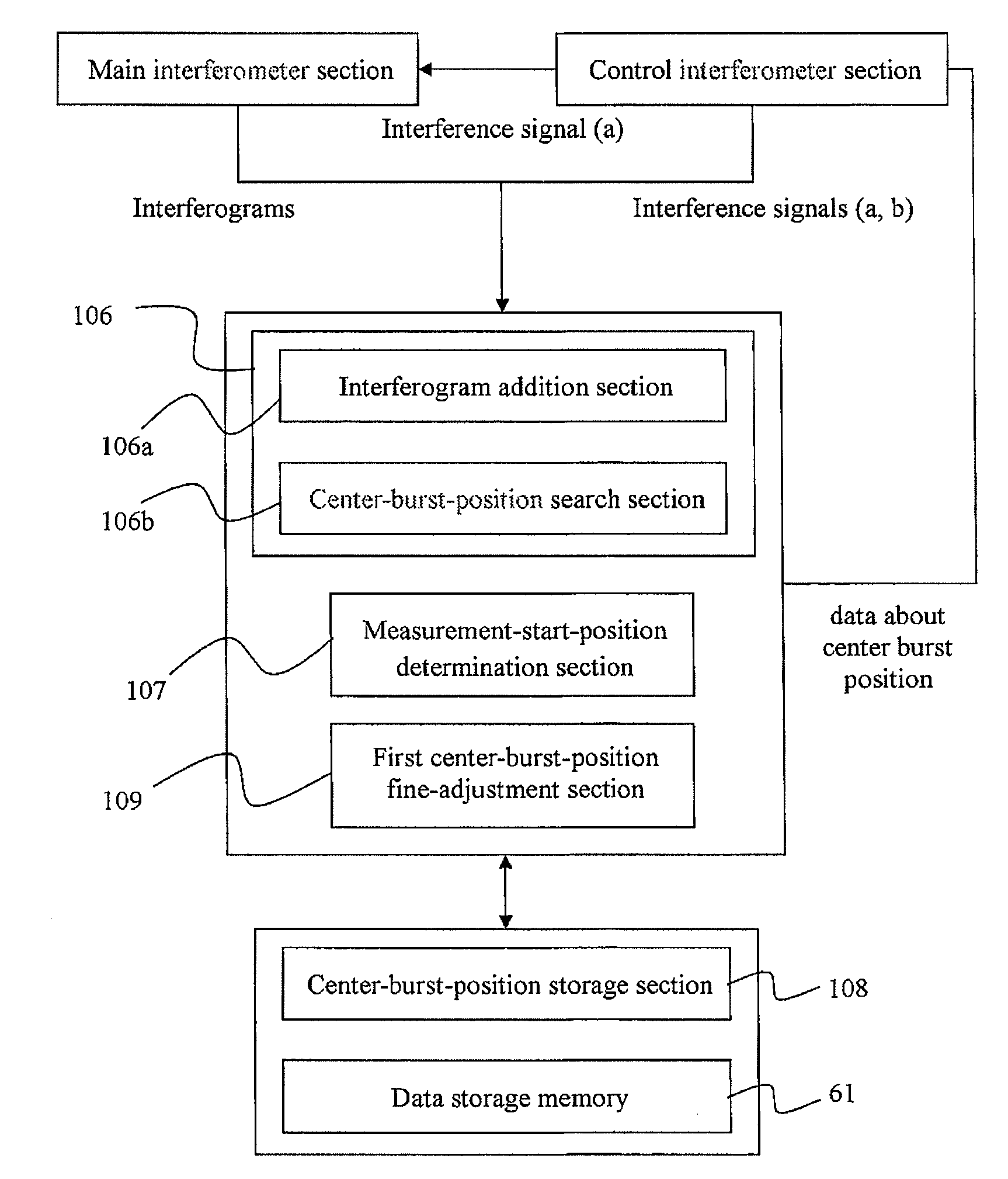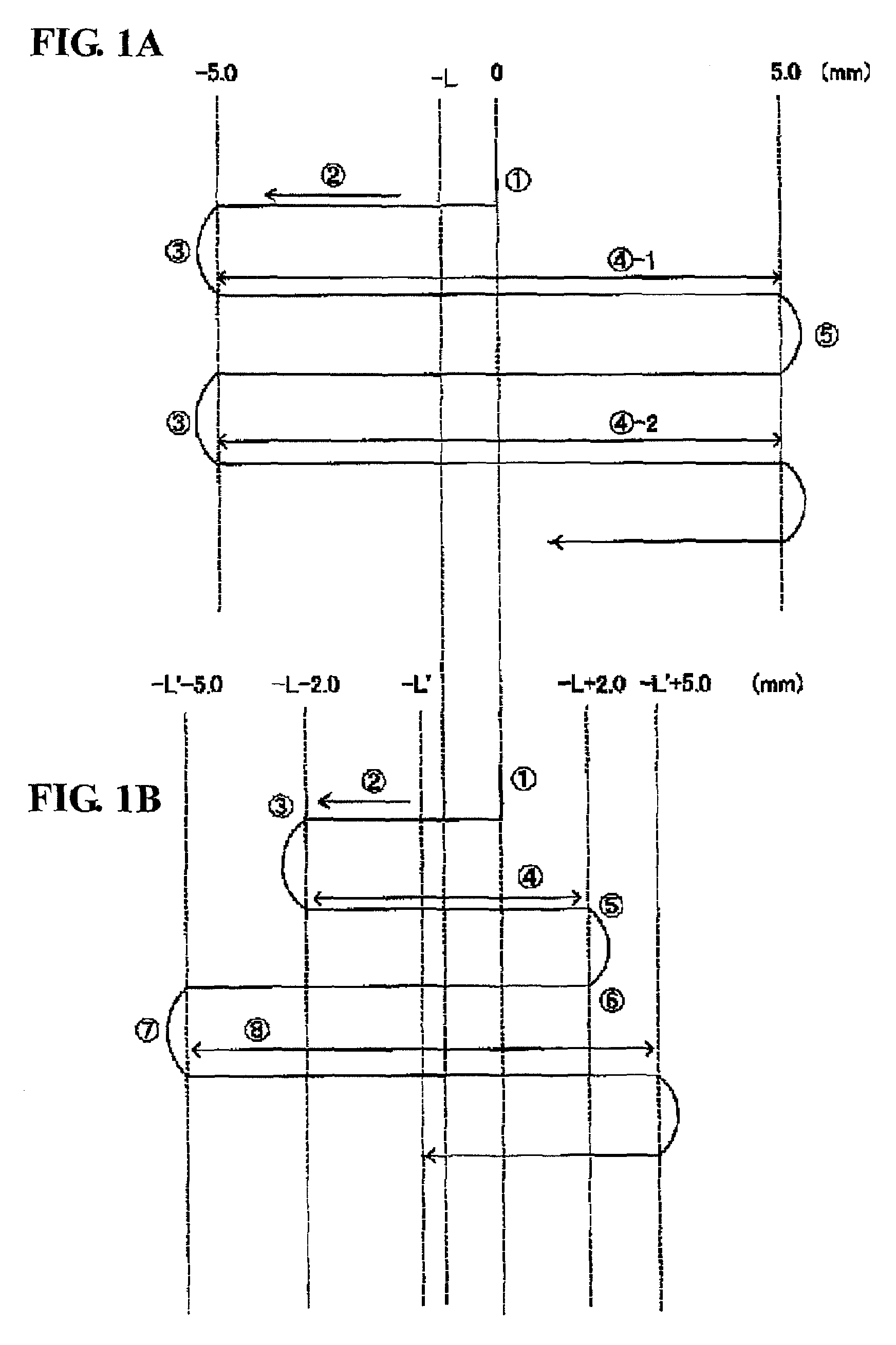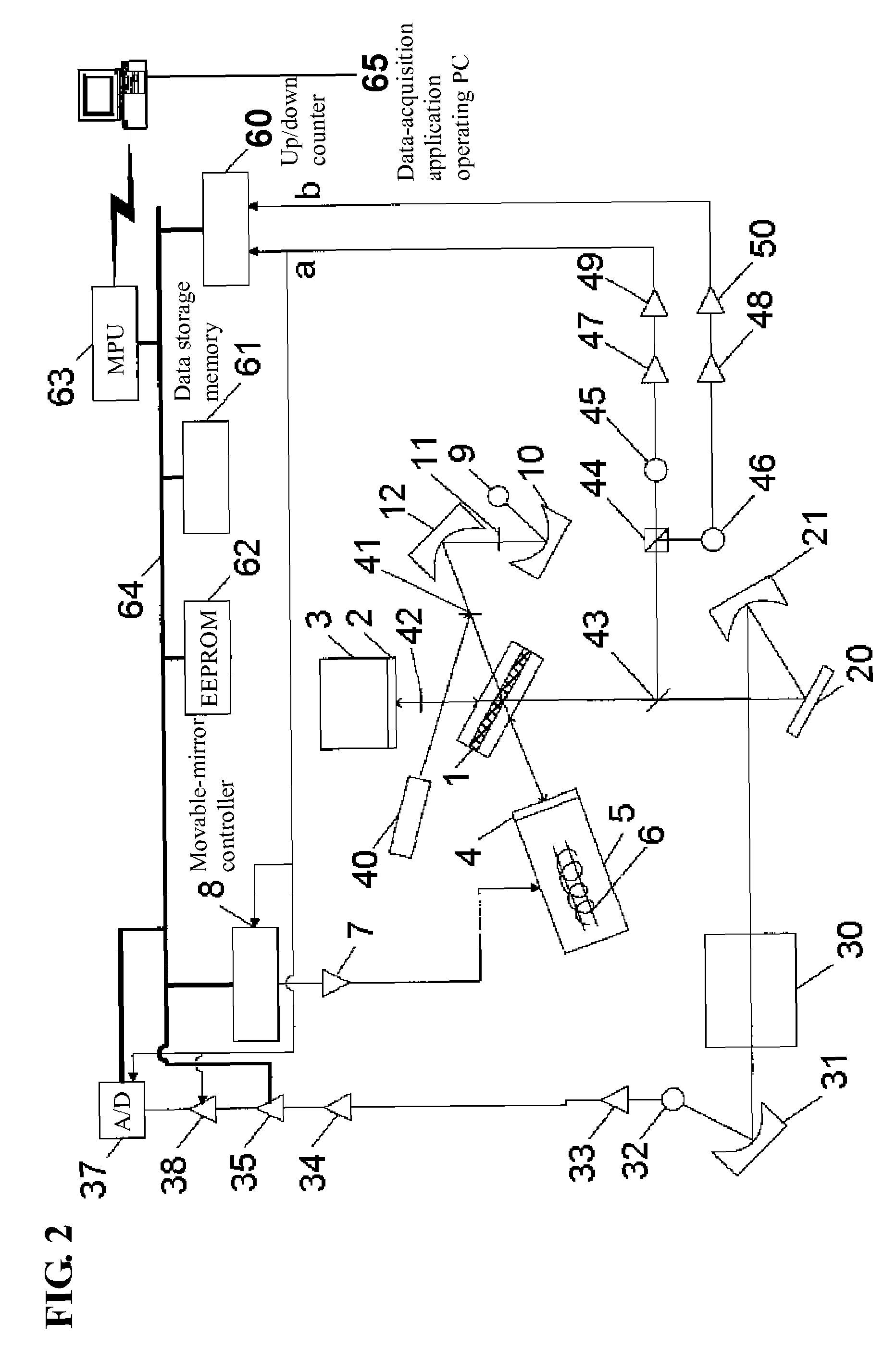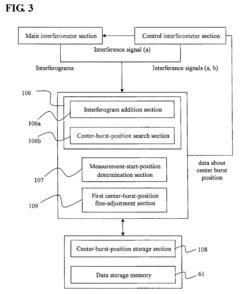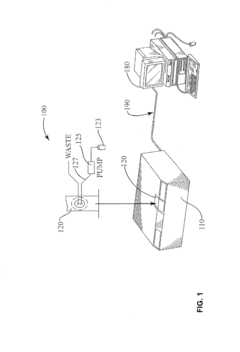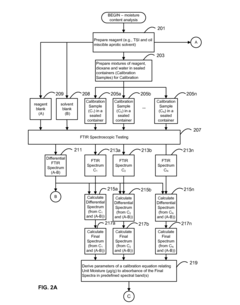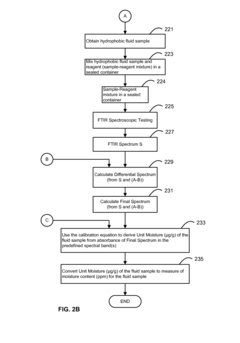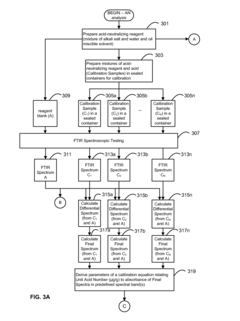FTIR vs Surface-enhanced Raman Scattering: Detailed Insights
SEP 22, 20259 MIN READ
Generate Your Research Report Instantly with AI Agent
Patsnap Eureka helps you evaluate technical feasibility & market potential.
FTIR and SERS Technology Background and Objectives
Fourier Transform Infrared Spectroscopy (FTIR) and Surface-enhanced Raman Scattering (SERS) represent two pivotal analytical techniques that have revolutionized molecular identification and characterization across multiple scientific disciplines. The evolution of these technologies spans several decades, with FTIR emerging in the mid-20th century as a refinement of traditional infrared spectroscopy, while SERS was discovered in the 1970s as an enhancement phenomenon of conventional Raman spectroscopy.
FTIR technology has progressed from bulky laboratory instruments to compact, portable devices capable of rapid analysis. This evolution has been driven by advancements in computing power, detector sensitivity, and optical components. The technique operates on the principle that molecular bonds absorb infrared radiation at specific frequencies, creating a unique spectral fingerprint for different compounds. This fundamental mechanism has remained unchanged, though implementation has been continuously refined.
SERS technology, conversely, has experienced more dramatic transformations since its serendipitous discovery by Fleischmann, Hendra, and McQuillan in 1974. Initially observed as an anomalously intense Raman signal from pyridine molecules adsorbed on roughened silver electrodes, SERS has evolved from a curious phenomenon to a powerful analytical technique. The development of nanofabrication methods has been particularly crucial, enabling the creation of precisely engineered substrates that can amplify Raman signals by factors of 10^6 to 10^11.
The technological trajectory for both techniques points toward increased sensitivity, specificity, and accessibility. For FTIR, this includes the development of quantum cascade lasers, advanced detector arrays, and sophisticated data processing algorithms. SERS development focuses on novel plasmonic materials, reproducible substrate fabrication, and integration with other analytical platforms.
The primary objective in advancing these technologies is to achieve reliable, sensitive detection of molecular species at increasingly lower concentrations, ultimately approaching single-molecule detection capabilities. Additionally, there is significant interest in developing field-deployable systems that maintain laboratory-grade performance while operating in diverse environments.
Another critical goal is the expansion of these techniques' application domains. While traditionally utilized in chemistry and materials science, both FTIR and SERS are increasingly finding applications in biomedical diagnostics, environmental monitoring, food safety, pharmaceutical quality control, and security screening. This cross-disciplinary adoption drives further innovation as the technologies adapt to meet the specific requirements of these diverse fields.
The convergence of these spectroscopic methods with artificial intelligence and machine learning represents another important technological objective, potentially enabling automated spectral interpretation, real-time analysis, and predictive capabilities that extend beyond simple molecular identification to functional characterization and behavior prediction.
FTIR technology has progressed from bulky laboratory instruments to compact, portable devices capable of rapid analysis. This evolution has been driven by advancements in computing power, detector sensitivity, and optical components. The technique operates on the principle that molecular bonds absorb infrared radiation at specific frequencies, creating a unique spectral fingerprint for different compounds. This fundamental mechanism has remained unchanged, though implementation has been continuously refined.
SERS technology, conversely, has experienced more dramatic transformations since its serendipitous discovery by Fleischmann, Hendra, and McQuillan in 1974. Initially observed as an anomalously intense Raman signal from pyridine molecules adsorbed on roughened silver electrodes, SERS has evolved from a curious phenomenon to a powerful analytical technique. The development of nanofabrication methods has been particularly crucial, enabling the creation of precisely engineered substrates that can amplify Raman signals by factors of 10^6 to 10^11.
The technological trajectory for both techniques points toward increased sensitivity, specificity, and accessibility. For FTIR, this includes the development of quantum cascade lasers, advanced detector arrays, and sophisticated data processing algorithms. SERS development focuses on novel plasmonic materials, reproducible substrate fabrication, and integration with other analytical platforms.
The primary objective in advancing these technologies is to achieve reliable, sensitive detection of molecular species at increasingly lower concentrations, ultimately approaching single-molecule detection capabilities. Additionally, there is significant interest in developing field-deployable systems that maintain laboratory-grade performance while operating in diverse environments.
Another critical goal is the expansion of these techniques' application domains. While traditionally utilized in chemistry and materials science, both FTIR and SERS are increasingly finding applications in biomedical diagnostics, environmental monitoring, food safety, pharmaceutical quality control, and security screening. This cross-disciplinary adoption drives further innovation as the technologies adapt to meet the specific requirements of these diverse fields.
The convergence of these spectroscopic methods with artificial intelligence and machine learning represents another important technological objective, potentially enabling automated spectral interpretation, real-time analysis, and predictive capabilities that extend beyond simple molecular identification to functional characterization and behavior prediction.
Market Applications and Demand Analysis
The market for spectroscopic analysis technologies continues to expand rapidly, with FTIR (Fourier Transform Infrared Spectroscopy) and SERS (Surface-enhanced Raman Scattering) representing two distinct yet complementary approaches that address different market needs. The global spectroscopy market, which encompasses these technologies, was valued at approximately $14.2 billion in 2022 and is projected to reach $20.8 billion by 2027, growing at a compound annual growth rate of 7.9%.
FTIR technology has established a strong presence in pharmaceutical quality control, environmental monitoring, and food safety sectors. Pharmaceutical companies represent the largest market segment, utilizing FTIR for raw material identification, formulation analysis, and counterfeit detection. The environmental monitoring sector has seen increased adoption rates of 12-15% annually as regulatory requirements for pollutant detection become more stringent globally.
Surface-enhanced Raman Scattering has experienced accelerated market growth, particularly in biomedical applications, security screening, and advanced materials research. The biomedical diagnostics segment has shown particular promise, with market adoption increasing by over 25% annually since 2020, driven by SERS' capability for ultra-sensitive detection of biomarkers and pathogens at concentrations previously undetectable by conventional methods.
Regional market analysis reveals North America currently holds the largest market share for both technologies at 38%, followed by Europe at 29% and Asia-Pacific at 24%. However, the Asia-Pacific region demonstrates the fastest growth rate at 11.3% annually, fueled by increasing industrialization, research investments, and healthcare infrastructure development in China, Japan, and India.
Industry-specific demand patterns show pharmaceutical and biotechnology sectors accounting for 34% of the combined FTIR and SERS market, followed by academic and research institutions (22%), chemical and material sciences (18%), food and beverage safety (14%), and environmental monitoring (12%). The remaining market share is distributed across various specialized applications including forensics, art conservation, and semiconductor manufacturing.
Customer needs analysis reveals distinct market segments: high-throughput industrial users prioritizing reliability and automation capabilities of FTIR, while research-intensive organizations value the superior sensitivity and molecular specificity offered by SERS. A growing segment of users (approximately 17% of the market) seeks integrated solutions that combine both technologies for comprehensive analytical capabilities.
Market forecasts indicate SERS technology will experience more rapid growth (15-18% annually) compared to the more mature FTIR market (6-8% annually) through 2028. This differential is attributed to emerging applications in point-of-care diagnostics, wearable sensors, and advanced materials characterization where SERS offers unique advantages in sensitivity and specificity.
FTIR technology has established a strong presence in pharmaceutical quality control, environmental monitoring, and food safety sectors. Pharmaceutical companies represent the largest market segment, utilizing FTIR for raw material identification, formulation analysis, and counterfeit detection. The environmental monitoring sector has seen increased adoption rates of 12-15% annually as regulatory requirements for pollutant detection become more stringent globally.
Surface-enhanced Raman Scattering has experienced accelerated market growth, particularly in biomedical applications, security screening, and advanced materials research. The biomedical diagnostics segment has shown particular promise, with market adoption increasing by over 25% annually since 2020, driven by SERS' capability for ultra-sensitive detection of biomarkers and pathogens at concentrations previously undetectable by conventional methods.
Regional market analysis reveals North America currently holds the largest market share for both technologies at 38%, followed by Europe at 29% and Asia-Pacific at 24%. However, the Asia-Pacific region demonstrates the fastest growth rate at 11.3% annually, fueled by increasing industrialization, research investments, and healthcare infrastructure development in China, Japan, and India.
Industry-specific demand patterns show pharmaceutical and biotechnology sectors accounting for 34% of the combined FTIR and SERS market, followed by academic and research institutions (22%), chemical and material sciences (18%), food and beverage safety (14%), and environmental monitoring (12%). The remaining market share is distributed across various specialized applications including forensics, art conservation, and semiconductor manufacturing.
Customer needs analysis reveals distinct market segments: high-throughput industrial users prioritizing reliability and automation capabilities of FTIR, while research-intensive organizations value the superior sensitivity and molecular specificity offered by SERS. A growing segment of users (approximately 17% of the market) seeks integrated solutions that combine both technologies for comprehensive analytical capabilities.
Market forecasts indicate SERS technology will experience more rapid growth (15-18% annually) compared to the more mature FTIR market (6-8% annually) through 2028. This differential is attributed to emerging applications in point-of-care diagnostics, wearable sensors, and advanced materials characterization where SERS offers unique advantages in sensitivity and specificity.
Current Technical Challenges and Limitations
Despite significant advancements in both FTIR and Surface-enhanced Raman Scattering (SERS) technologies, several technical challenges and limitations persist that hinder their broader application and effectiveness. FTIR spectroscopy faces fundamental sensitivity constraints, particularly when analyzing samples at trace concentrations below parts per million. This limitation becomes especially problematic when investigating complex biological samples or environmental contaminants at ultra-low concentrations.
Water interference represents another significant challenge for FTIR analysis. The strong absorption bands of water in the mid-infrared region often mask important spectral features of target analytes, necessitating complex sample preparation procedures or specialized accessories like attenuated total reflection (ATR) modules. These requirements increase operational complexity and may introduce additional variables affecting measurement accuracy.
Resolution limitations also affect FTIR technology, particularly when distinguishing between closely related molecular structures or when analyzing complex mixtures with overlapping spectral features. The diffraction limit fundamentally constrains spatial resolution in conventional FTIR microscopy to approximately 3-10 μm, which proves inadequate for many nanoscale applications in materials science and biological research.
SERS technology, while offering exceptional sensitivity advantages, faces its own set of challenges. Reproducibility remains a persistent issue, with signal intensities often varying significantly between measurements due to inconsistencies in substrate fabrication, "hot spot" distribution, and molecular orientation on the enhancing surface. This variability complicates quantitative analysis and limits SERS applications in standardized testing environments.
Substrate stability and shelf-life present additional challenges for SERS implementation. Many high-performance SERS substrates degrade over time due to oxidation, contamination, or structural changes, limiting their practical utility in field applications or long-term studies. The cost of producing consistent, high-quality SERS substrates at scale remains prohibitively high for many routine analytical applications.
Signal interpretation complexity further complicates SERS analysis. The enhancement mechanism can alter normal Raman selection rules, leading to spectral features that differ significantly from conventional Raman spectra of the same analyte. This phenomenon necessitates specialized reference libraries and interpretation expertise, creating barriers to widespread adoption.
Both technologies also face integration challenges with existing analytical workflows and instrumentation platforms. The specialized equipment, expertise, and sample preparation requirements often prevent seamless incorporation into established laboratory processes, limiting their accessibility to specialized research facilities rather than routine analytical environments.
Water interference represents another significant challenge for FTIR analysis. The strong absorption bands of water in the mid-infrared region often mask important spectral features of target analytes, necessitating complex sample preparation procedures or specialized accessories like attenuated total reflection (ATR) modules. These requirements increase operational complexity and may introduce additional variables affecting measurement accuracy.
Resolution limitations also affect FTIR technology, particularly when distinguishing between closely related molecular structures or when analyzing complex mixtures with overlapping spectral features. The diffraction limit fundamentally constrains spatial resolution in conventional FTIR microscopy to approximately 3-10 μm, which proves inadequate for many nanoscale applications in materials science and biological research.
SERS technology, while offering exceptional sensitivity advantages, faces its own set of challenges. Reproducibility remains a persistent issue, with signal intensities often varying significantly between measurements due to inconsistencies in substrate fabrication, "hot spot" distribution, and molecular orientation on the enhancing surface. This variability complicates quantitative analysis and limits SERS applications in standardized testing environments.
Substrate stability and shelf-life present additional challenges for SERS implementation. Many high-performance SERS substrates degrade over time due to oxidation, contamination, or structural changes, limiting their practical utility in field applications or long-term studies. The cost of producing consistent, high-quality SERS substrates at scale remains prohibitively high for many routine analytical applications.
Signal interpretation complexity further complicates SERS analysis. The enhancement mechanism can alter normal Raman selection rules, leading to spectral features that differ significantly from conventional Raman spectra of the same analyte. This phenomenon necessitates specialized reference libraries and interpretation expertise, creating barriers to widespread adoption.
Both technologies also face integration challenges with existing analytical workflows and instrumentation platforms. The specialized equipment, expertise, and sample preparation requirements often prevent seamless incorporation into established laboratory processes, limiting their accessibility to specialized research facilities rather than routine analytical environments.
Comparative Analysis of FTIR and SERS Methodologies
01 FTIR and SERS for molecular identification and analysis
The combination of Fourier Transform Infrared (FTIR) spectroscopy and Surface-enhanced Raman Scattering (SERS) provides complementary molecular information for comprehensive sample analysis. FTIR identifies functional groups through infrared absorption, while SERS enhances Raman signals for detecting trace amounts of substances. Together, these techniques enable precise molecular identification, structural characterization, and quantitative analysis across various fields including pharmaceuticals, forensics, and materials science.- FTIR and SERS for molecular identification and characterization: Fourier Transform Infrared (FTIR) spectroscopy and Surface-enhanced Raman Scattering (SERS) are complementary techniques used for molecular identification and characterization. FTIR provides information about functional groups through infrared absorption, while SERS enhances the Raman signal for detecting trace amounts of substances. These techniques together offer comprehensive molecular fingerprinting capabilities for various analytical applications.
- SERS substrate development and optimization: Development of specialized substrates is crucial for enhancing SERS sensitivity. Various materials and structures are used to create effective SERS substrates, including nanoparticles, nanorods, and patterned surfaces. These substrates amplify the Raman signal through localized surface plasmon resonance, enabling detection of molecules at extremely low concentrations. Optimization of substrate morphology and composition significantly impacts analytical performance.
- Combined spectroscopic techniques for enhanced analysis: Integration of multiple spectroscopic methods, including FTIR, SERS, and other techniques like mass spectrometry, provides more comprehensive analytical capabilities. This multimodal approach allows for validation of results across different platforms and extraction of complementary information from samples. Combined techniques are particularly valuable for complex sample analysis where a single method may be insufficient for complete characterization.
- Applications in biomedical and environmental analysis: FTIR and SERS spectroscopic techniques are widely applied in biomedical diagnostics and environmental monitoring. These methods enable detection of biomarkers, pathogens, pollutants, and other substances of interest at low concentrations. The non-destructive nature of these techniques makes them suitable for analyzing biological samples, while their sensitivity allows for environmental contaminant detection at trace levels.
- Data processing and analysis methods: Advanced data processing techniques are essential for interpreting FTIR and SERS spectral data. These include multivariate statistical analysis, machine learning algorithms, and spectral preprocessing methods to extract meaningful information from complex spectra. Pattern recognition and chemometric approaches help identify spectral signatures associated with specific compounds or conditions, improving the accuracy and reliability of analytical results.
02 SERS substrate development and enhancement mechanisms
Advanced SERS substrate designs incorporate nanostructured materials such as noble metal nanoparticles, nanorods, and patterned surfaces to create electromagnetic hotspots that significantly amplify Raman signals. These substrates enable detection limits down to single-molecule levels through plasmonic enhancement effects. Recent innovations include flexible substrates, hierarchical structures, and controlled gap distances between nanoparticles to optimize enhancement factors while maintaining reproducibility and stability for practical applications.Expand Specific Solutions03 Portable and integrated spectroscopic systems
Miniaturized and integrated spectroscopic systems combine FTIR and SERS capabilities in portable devices for field analysis. These systems incorporate compact light sources, detectors, and microfluidic sample handling components to enable on-site measurements without requiring laboratory infrastructure. Applications include environmental monitoring, food safety testing, and point-of-care diagnostics where rapid analysis is critical. Recent developments focus on smartphone-compatible devices and battery-operated systems with automated data processing capabilities.Expand Specific Solutions04 Data fusion and multivariate analysis techniques
Advanced computational methods enable the fusion of data from FTIR and SERS measurements to extract maximum information from spectroscopic analyses. Machine learning algorithms, principal component analysis, and chemometric approaches help identify patterns in complex spectral data and remove background interference. These techniques improve sensitivity, specificity, and reliability of molecular identification, particularly in mixtures or complex matrices. The integration of spectral databases with analysis software facilitates automated identification and quantification of compounds.Expand Specific Solutions05 Biomedical and pharmaceutical applications
FTIR and SERS spectroscopic techniques are increasingly applied in biomedical research and pharmaceutical analysis. These methods enable label-free detection of biomarkers, monitoring of drug delivery systems, and analysis of biological tissues with high specificity. The non-destructive nature of these techniques allows for in-situ analysis of biological samples with minimal preparation. Recent developments include SERS-active nanoparticles for targeted cellular imaging, therapeutic monitoring, and early disease detection through spectral fingerprinting of biological fluids.Expand Specific Solutions
Leading Research Institutions and Industry Players
The FTIR vs Surface-enhanced Raman Scattering technology landscape is currently in a growth phase, with increasing market adoption across pharmaceutical, chemical, and biomedical sectors. The global market for these spectroscopic technologies is expanding at approximately 8-10% annually, driven by demand for more sensitive molecular detection methods. Technologically, FTIR represents a mature solution with established players like Agilent Technologies, Thermo Fisher (not listed), and Bruker dominating, while SERS is emerging as a disruptive technology offering superior sensitivity. Research institutions like Shanghai University, Jilin University, and Industrial Technology Research Institute are advancing SERS applications, while companies including Renishaw Diagnostics and FUJIFILM are commercializing innovative implementations. Intel and Philips are leveraging these technologies for semiconductor and healthcare applications respectively, indicating cross-industry potential.
Industrial Technology Research Institute
Technical Solution: The Industrial Technology Research Institute (ITRI) has developed an integrated spectroscopic platform that combines FTIR and SERS technologies with advanced data analytics for industrial applications. Their system features a dual-mode optical configuration that enables seamless switching between techniques without sample repositioning, maintaining spatial registration between measurement modes[1]. ITRI's SERS substrates utilize proprietary nanofabrication techniques to create highly uniform plasmonic structures with enhancement factors consistently exceeding 10^6 across the entire active area[2]. Their technology incorporates automated sample preparation modules specifically designed for industrial samples, including specialized extraction protocols for complex matrices like polymers, pharmaceuticals, and semiconductor materials. ITRI has pioneered chemometric algorithms that perform correlation analysis between FTIR and SERS spectra, enabling more comprehensive chemical fingerprinting than either technique alone. Their systems have demonstrated particular success in quality control applications, where the complementary information from both techniques has improved defect detection rates by approximately 40% compared to single-technique approaches[3]. ITRI's platform includes specialized software for regulatory compliance documentation, facilitating adoption in highly regulated industries.
Strengths: Robust engineering optimized for industrial environments; excellent reproducibility through automated workflows; specialized sample preparation capabilities for diverse materials; comprehensive software for quality control applications. Weaknesses: Less sensitivity than research-grade systems; optimization for industrial throughput sometimes sacrifices ultimate detection limits; higher maintenance requirements in production environments.
Agilent Technologies, Inc.
Technical Solution: Agilent Technologies has developed advanced FTIR and SERS analytical platforms that integrate sophisticated sampling techniques with powerful data analysis software. Their FTIR solutions feature high-resolution spectroscopy with rapid scan capabilities (up to 65 spectra/second) and diamond ATR accessories for versatile sample analysis[1]. For SERS applications, Agilent has engineered specialized substrates with controlled nanostructures that provide enhancement factors exceeding 10^6, enabling detection limits in the nanomolar to picomolar range[2]. Their integrated approach combines hardware excellence with machine learning algorithms for automated spectral interpretation, allowing researchers to rapidly identify molecular fingerprints in complex matrices. Agilent's systems incorporate temperature-controlled sample stages and automated background correction to ensure reproducibility across diverse environmental conditions.
Strengths: Superior sensitivity for trace analysis with SERS technology; comprehensive software suite for data interpretation; excellent reproducibility through automated calibration protocols. Weaknesses: Higher initial investment compared to basic spectroscopy systems; SERS substrates have limited shelf-life; specialized training required for optimal utilization of advanced features.
Key Patents and Scientific Breakthroughs
Fourier transform infrared spectrophotometer
PatentInactiveUS7535004B2
Innovation
- The implementation of a center-burst-position detection section that performs addition processing on interferogram intensities to produce a cumulative interferogram, correcting positional deviations and enhancing the detection of the center burst position by increasing the intensity of true peaks while canceling out noise peaks, thereby ensuring accurate detection even under low light conditions.
FTIR System and Method for Compositional Analysis of Matter
PatentInactiveUS20170059411A1
Innovation
- A system and method using FTIR spectroscopy that involves preparing reagents reacting with the sample to produce carbon dioxide gas, allowing for calibration equations to be derived from standard mixtures, enabling precise measurement of moisture, acidity, or basicity by analyzing absorbance in specific spectral bands, which can be applied to various hydrophobic fluids and solid matrices.
Instrumentation and Hardware Requirements
The instrumentation and hardware requirements for FTIR and Surface-enhanced Raman Scattering (SERS) technologies differ significantly, reflecting their distinct operational principles and applications.
FTIR spectroscopy systems typically consist of four primary components: an infrared source, an interferometer, a sample compartment, and a detector. The source generates infrared radiation, commonly using a silicon carbide element (Globar) or a tungsten-halogen lamp. The interferometer, often a Michelson interferometer, modulates the infrared beam, creating an interferogram that contains spectral information. Sample compartments vary based on application needs, accommodating transmission, reflection, or attenuated total reflection (ATR) modes. Detectors range from thermal detectors (pyroelectric, thermopile) to quantum detectors (MCT, InGaAs), with selection depending on required sensitivity and spectral range.
SERS instrumentation, conversely, builds upon conventional Raman spectroscopy systems with specialized substrates. A typical SERS setup includes a monochromatic light source (usually a laser operating in visible or near-infrared range), specialized SERS-active substrates, collection optics, a spectrometer, and a detector. The laser excites the sample placed on metallic nanostructures (typically gold or silver), which enhance the Raman signal by factors of 10^6 to 10^14. High-quality bandpass filters and notch filters are essential to eliminate laser line interference.
The cost structures of these technologies differ substantially. FTIR systems range from $20,000 for basic benchtop models to $100,000+ for research-grade instruments with advanced capabilities. SERS systems typically cost between $50,000 and $200,000, with additional recurring expenses for specialized substrates that can cost $20-100 per analysis.
Space requirements also contrast significantly. FTIR systems are generally more compact, with benchtop models occupying approximately 2-3 square feet, while SERS systems often require dedicated optical tables and vibration isolation, occupying 10-20 square feet of laboratory space.
Maintenance considerations differ as well. FTIR systems require periodic replacement of desiccants to maintain an anhydrous environment and occasional source replacement (every 3-5 years). SERS systems demand more frequent maintenance, including laser calibration, alignment of optical components, and regular cleaning of optical surfaces to prevent contamination that could interfere with the enhanced Raman signals.
FTIR spectroscopy systems typically consist of four primary components: an infrared source, an interferometer, a sample compartment, and a detector. The source generates infrared radiation, commonly using a silicon carbide element (Globar) or a tungsten-halogen lamp. The interferometer, often a Michelson interferometer, modulates the infrared beam, creating an interferogram that contains spectral information. Sample compartments vary based on application needs, accommodating transmission, reflection, or attenuated total reflection (ATR) modes. Detectors range from thermal detectors (pyroelectric, thermopile) to quantum detectors (MCT, InGaAs), with selection depending on required sensitivity and spectral range.
SERS instrumentation, conversely, builds upon conventional Raman spectroscopy systems with specialized substrates. A typical SERS setup includes a monochromatic light source (usually a laser operating in visible or near-infrared range), specialized SERS-active substrates, collection optics, a spectrometer, and a detector. The laser excites the sample placed on metallic nanostructures (typically gold or silver), which enhance the Raman signal by factors of 10^6 to 10^14. High-quality bandpass filters and notch filters are essential to eliminate laser line interference.
The cost structures of these technologies differ substantially. FTIR systems range from $20,000 for basic benchtop models to $100,000+ for research-grade instruments with advanced capabilities. SERS systems typically cost between $50,000 and $200,000, with additional recurring expenses for specialized substrates that can cost $20-100 per analysis.
Space requirements also contrast significantly. FTIR systems are generally more compact, with benchtop models occupying approximately 2-3 square feet, while SERS systems often require dedicated optical tables and vibration isolation, occupying 10-20 square feet of laboratory space.
Maintenance considerations differ as well. FTIR systems require periodic replacement of desiccants to maintain an anhydrous environment and occasional source replacement (every 3-5 years). SERS systems demand more frequent maintenance, including laser calibration, alignment of optical components, and regular cleaning of optical surfaces to prevent contamination that could interfere with the enhanced Raman signals.
Data Processing and Machine Learning Integration
Data processing and machine learning integration represent critical components in the comparative analysis of FTIR and Surface-enhanced Raman Scattering (SERS) technologies. The exponential growth in spectral data volume necessitates sophisticated computational approaches to extract meaningful insights and enhance analytical capabilities.
Traditional data processing for FTIR and SERS involves baseline correction, noise reduction, and spectral normalization. However, modern spectroscopic analysis has evolved beyond these fundamental techniques. Advanced preprocessing methods now include wavelet transforms for multi-resolution analysis, Savitzky-Golay filtering for smoothing while preserving peak characteristics, and adaptive iterative algorithms for automated baseline correction that significantly improve spectral quality.
Machine learning integration has revolutionized spectroscopic data interpretation. Supervised learning algorithms, particularly Support Vector Machines (SVMs) and Random Forests, have demonstrated exceptional performance in classifying spectral patterns from both FTIR and SERS data. Deep learning approaches, including Convolutional Neural Networks (CNNs) and Recurrent Neural Networks (RNNs), excel at extracting hierarchical features from complex spectral datasets, offering superior performance in identifying subtle spectral variations that might elude traditional analysis methods.
Transfer learning techniques have emerged as particularly valuable in spectroscopic applications, allowing models trained on large FTIR datasets to be adapted for SERS analysis with minimal additional training data. This approach addresses the common challenge of limited training samples in specialized applications while maintaining high analytical accuracy.
Dimensionality reduction techniques such as Principal Component Analysis (PCA) and t-Distributed Stochastic Neighbor Embedding (t-SNE) have proven essential for visualizing high-dimensional spectral data and identifying natural clustering patterns. These methods facilitate the identification of spectral markers that differentiate between sample groups, enhancing diagnostic capabilities in both technologies.
Real-time processing frameworks have been developed to enable on-the-fly analysis of spectral data, particularly beneficial for SERS applications in field settings. These frameworks incorporate edge computing principles to deliver immediate analytical results without requiring connection to centralized computing resources.
The integration of automated machine learning (AutoML) platforms has democratized advanced spectral analysis, allowing researchers without extensive data science expertise to implement sophisticated analytical pipelines. These systems automatically optimize model selection, hyperparameter tuning, and feature engineering for spectroscopic data, significantly accelerating the development of analytical solutions.
Traditional data processing for FTIR and SERS involves baseline correction, noise reduction, and spectral normalization. However, modern spectroscopic analysis has evolved beyond these fundamental techniques. Advanced preprocessing methods now include wavelet transforms for multi-resolution analysis, Savitzky-Golay filtering for smoothing while preserving peak characteristics, and adaptive iterative algorithms for automated baseline correction that significantly improve spectral quality.
Machine learning integration has revolutionized spectroscopic data interpretation. Supervised learning algorithms, particularly Support Vector Machines (SVMs) and Random Forests, have demonstrated exceptional performance in classifying spectral patterns from both FTIR and SERS data. Deep learning approaches, including Convolutional Neural Networks (CNNs) and Recurrent Neural Networks (RNNs), excel at extracting hierarchical features from complex spectral datasets, offering superior performance in identifying subtle spectral variations that might elude traditional analysis methods.
Transfer learning techniques have emerged as particularly valuable in spectroscopic applications, allowing models trained on large FTIR datasets to be adapted for SERS analysis with minimal additional training data. This approach addresses the common challenge of limited training samples in specialized applications while maintaining high analytical accuracy.
Dimensionality reduction techniques such as Principal Component Analysis (PCA) and t-Distributed Stochastic Neighbor Embedding (t-SNE) have proven essential for visualizing high-dimensional spectral data and identifying natural clustering patterns. These methods facilitate the identification of spectral markers that differentiate between sample groups, enhancing diagnostic capabilities in both technologies.
Real-time processing frameworks have been developed to enable on-the-fly analysis of spectral data, particularly beneficial for SERS applications in field settings. These frameworks incorporate edge computing principles to deliver immediate analytical results without requiring connection to centralized computing resources.
The integration of automated machine learning (AutoML) platforms has democratized advanced spectral analysis, allowing researchers without extensive data science expertise to implement sophisticated analytical pipelines. These systems automatically optimize model selection, hyperparameter tuning, and feature engineering for spectroscopic data, significantly accelerating the development of analytical solutions.
Unlock deeper insights with Patsnap Eureka Quick Research — get a full tech report to explore trends and direct your research. Try now!
Generate Your Research Report Instantly with AI Agent
Supercharge your innovation with Patsnap Eureka AI Agent Platform!
